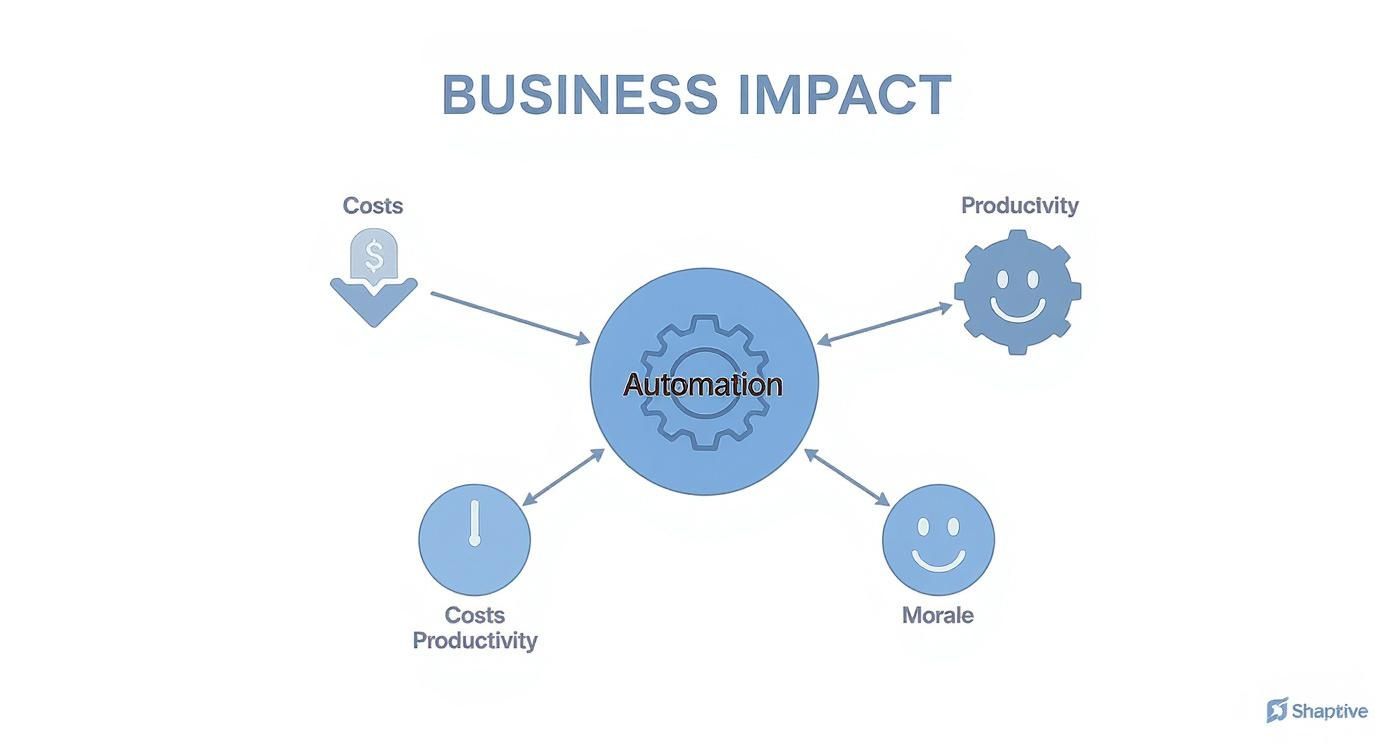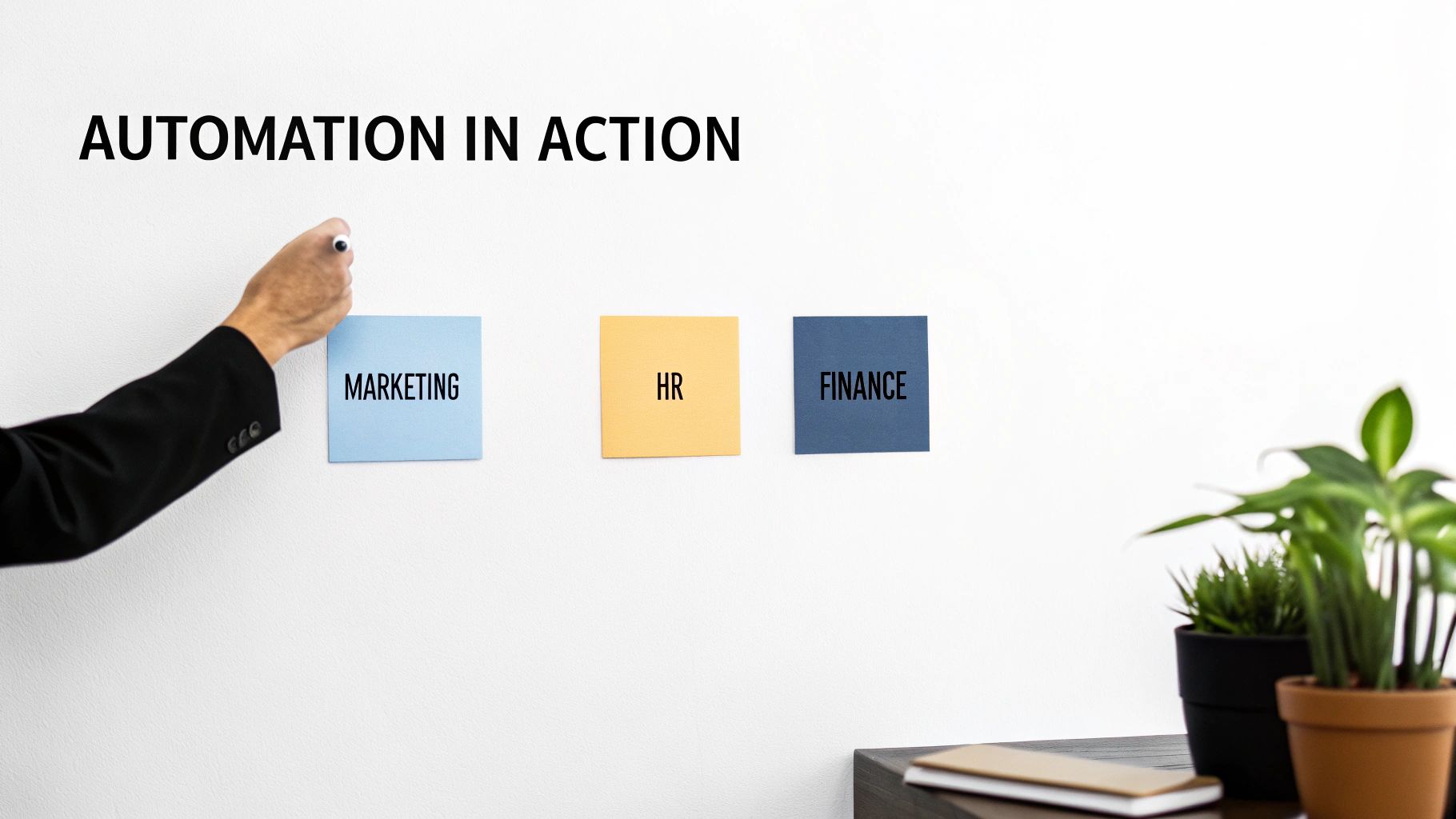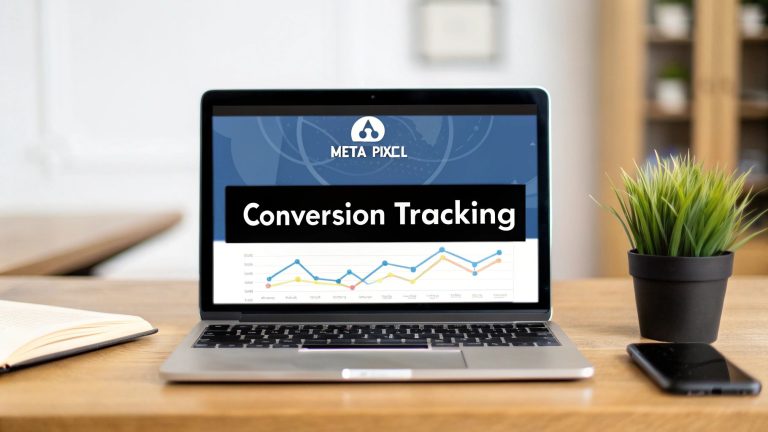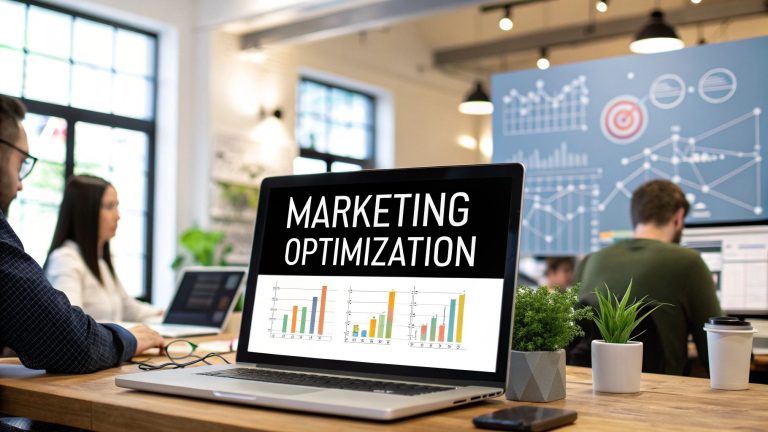What Is Automated Workflow? A Practical Guide
Think of an automated workflow as setting up a series of digital dominoes. You give the first one a gentle push (that’s your trigger), and the rest fall into place perfectly, every single time, without you lifting another finger. It's a sequence of tasks, powered by technology, that runs on its own based on rules you've already defined.
What Is an Automated Workflow?
Let's get practical. Consider all the little, repetitive steps you take every day at work. Onboarding a new client is a classic example. You have to send a welcome email, create their profile in your CRM, set up a new project in your management tool, and then ping your team on Slack to let them know.
Done manually, this is a minefield of potential mistakes. A typo in the email, a forgotten step, a delay in notifying the team—any of these can make for a clunky first impression.

This is where automation changes the game. The moment a new client signs that contract (the trigger), the system springs into action, handling that entire checklist for you. Instantly.
An automated workflow is simply a business process you've taught your software to handle for you. It turns a manual, human-powered checklist into an automatic sequence, freeing you and your team up for work that actually requires a brain.
From Manual Effort to Automated Efficiency
The big idea here is to map out a process once, build it into your software, and then trust it to run flawlessly forever. You’re swapping out sticky notes and human memory for a reliable, repeatable system. The jump from manual to automatic is huge.
For a deeper dive into the basics, this guide on What Is Workflow Automation is a great place to start. It really breaks down how this shift drives business efficiency.
To help visualize this shift, here's a simple breakdown of how manual and automated workflows stack up.
Manual vs Automated Workflows At a Glance
| Characteristic | Manual Workflow | Automated Workflow |
|---|---|---|
| Execution | Relies on human action for every step. | Runs automatically based on pre-set rules. |
| Speed | Slow, limited by human availability. | Instantaneous, 24/7 operation. |
| Consistency | Varies; prone to human error and shortcuts. | 100% consistent every single time. |
| Scalability | Difficult; requires hiring more people. | Easy; handles increased volume without issue. |
| Visibility | Hard to track progress without check-ins. | Provides real-time status and clear audit trails. |
| Cost | High labor costs for repetitive tasks. | Low operational cost after initial setup. |
As you can see, automation isn't just about doing things faster—it's about doing them better, more reliably, and at scale.
This kind of power isn't just for massive companies anymore. Modern tools make it easy for businesses of any size to automate their most important tasks. It all comes down to three simple building blocks:
- Triggers: The starting pistol. This is the event that kicks off the workflow, like a new form submission or a paid invoice.
- Actions: The workhorses. These are the actual tasks the system performs, like sending an email, updating a spreadsheet, or creating a task.
- Conditions: The traffic cops. This is the "if this, then that" logic that tells your workflow which path to take based on the data it receives.
By snapping these pieces together, you build a powerful, self-driving process that saves an incredible amount of time and keeps everything consistent. You're basically creating a digital assistant for your team, one that handles the boring stuff so your people can focus on what they do best.
The Real Business Impact of Workflow Automation
So, we know what an automated workflow is, but what does it actually do for a business? The real magic isn't in the tech itself, but in the tangible results that start showing up on your bottom line. Think of it less like a software upgrade and more like a direct investment in your company's health.
The impact ripples across every single department, from sales and marketing right through to finance and HR.
Reclaiming Your Team's Time and Energy
The first and most obvious win is a massive cut in operational costs. Just stop and think about the countless hours your team burns on manual, repetitive work. We're talking about tasks like data entry, generating the same report every week, or the tedious back-and-forth of onboarding a new client. Every one of those hours has a dollar sign attached to it.
Automation steps in and takes over that grind, freeing up your budget and, more importantly, your people to focus on the big-picture stuff that actually grows the business.
This shift naturally leads to a huge boost in productivity. When your team isn't stuck doing soul-crushing, copy-paste tasks, they can finally dig into the complex, creative, and customer-facing work they were hired for in the first place. It’s not just about getting more done; it's about getting the right work done.
And don't underestimate the effect this has on morale. Nobody gets excited about spending their day buried in spreadsheets. By automating the grunt work, you empower your team, slash burnout, and create a workplace where people feel like their skills are actually being put to good use.
An automated workflow is simple: it lets your best people solve your biggest problems, instead of getting bogged down by the smallest, most repetitive ones.
Hitting Near-Perfect Accuracy
Another game-changer is the near-elimination of human error. Even your most careful and dedicated employee can make a mistake. A typo here, a missed step there—it happens. While these little errors seem minor, they add up fast, leading to costly rework, compliance headaches, or a soured customer experience.
An automated system, on the other hand, performs its tasks with perfect consistency, every single time. This level of precision is exactly why automation is becoming a must-have for any process where accuracy is non-negotiable, like financial reporting or inventory management. For more ideas, you can check out our guide on how to streamline business processes for maximum efficiency.
The numbers don't lie. A staggering 94% of companies are still bogged down by repetitive, manual tasks—that's a massive opportunity just waiting to be tapped.
Automation has already improved the day-to-day jobs of 90% of knowledge workers and boosted productivity for 66% of them. These stats are driving a huge shift, with nearly 9 in 10 employees now saying they trust automation to deliver error-free results. You can discover more insights about automation statistics on VenaSolutions.com to see just how big this trend is becoming.
Understanding the Building Blocks of Automation
So, what's really going on inside an automated workflow? To get it, you have to look under the hood. Every single automation, no matter how simple or complicated it seems, is built from the same three core parts.
Think of them as the ingredients in a recipe for getting things done without lifting a finger.
Triggers: The Starting Gun
Right at the beginning of any workflow, you have the Trigger. This is the specific event that fires the starting pistol and kicks the whole process into gear. It’s the digital version of "On your mark, get set, go!"
A trigger can be almost anything you can think of. A customer filling out a form on your website? That's a trigger. An invoice getting marked as "paid" in your accounting software? That's a trigger, too. It could even be something as simple as the clock striking 9:00 AM every Monday morning.
This visual breaks down how putting these building blocks together creates real-world results, impacting everything from your bottom line to your team's sanity.

The magic happens when these pieces work together seamlessly, creating a powerful system that delivers tangible business outcomes.
Actions: The Automated To-Do List
Once that trigger fires, the workflow jumps to the Actions. These are the specific, individual tasks the system carries out automatically, one after another. If the trigger is the command, the actions are the troops on the ground getting it done.
Let's stick with our example of someone submitting a form. The actions might look something like this:
- Action 1: Instantly shoot a personalized confirmation email to the person who just signed up.
- Action 2: Add their contact details as a new row in a shared Google Sheet.
- Action 3: Create a new lead record for them in your company's CRM.
Each action knocks out a step that a person would otherwise have to do by hand, making sure nothing ever falls through the cracks. This is where concepts like what is data synchronization really shine, because these actions can keep all your different software perfectly in sync without you having to think about it.
Conditions: The 'If-Then' Brains of the Operation
Finally, we get to the smartest part of any automated workflow: the Logic, or Conditions. This is what gives your automation a brain, letting it make decisions on the fly. It's the traffic cop directing where tasks should go based on simple "if this, then that" rules.
Conditions allow your workflow to adapt. Instead of just blindly following one rigid path, it can actually look at the data and pick the right set of actions for that specific situation.
For instance, a condition could peek at the info from that form submission. If the "Industry" field says "Manufacturing," then the workflow assigns that lead to Sales Rep A. But if the industry is "Technology," then it sends it over to Sales Rep B instead.
This simple logic makes sure the right things happen for the right reasons, turning your workflow from just efficient to truly intelligent.
Putting Automated Workflows to Work: Real-World Examples
It’s one thing to talk about triggers, actions, and conditions in theory. It’s another thing entirely to see them in action, solving real problems that businesses face every single day. That’s where the value of automated workflows really clicks.
Think of automation as the digital backbone for your company. It keeps things running smoothly and consistently across different departments—from marketing to finance—all without someone having to manually check in on every little task.

Let's dive into a few concrete examples of how businesses are putting these workflows to work. These aren't just pie-in-the-sky ideas; they're practical, high-impact automations you could set up in your own business right now.
Marketing Lead Nurturing
Every marketer knows the challenge: someone shows interest, but following up quickly and consistently is tough to do manually. An automated workflow turns this into a powerhouse for building relationships from the moment a lead comes in.
- Trigger: A potential customer fills out a "Download Our Guide" form on your website.
- Actions: The system instantly shoots them a personalized email with the download link. At the same time, it adds their contact info to your CRM, tags them as a "New Lead," and kicks off a five-day email series to keep the conversation going.
- Outcome: The new lead gets value right away and is guided through a thoughtful journey, warming them up for a sales call. And the sales team? They get a well-informed prospect without lifting a finger.
The real goal here is to create a seamless experience that makes your prospect feel valued, ensuring no lead ever goes cold. This automated consistency builds trust right from the start.
Human Resources Onboarding
A new hire’s first day can be a whirlwind of paperwork and confusion. An automated onboarding workflow smooths out the entire process, making new employees feel welcome and setting them up for success from day one. You can see how this same logic applies to other campaigns by exploring these marketing automation workflow examples.
- Trigger: An HR manager updates a candidate's status to "Hired" in the company's hiring software.
- Actions: That single click sets off a chain reaction. An official offer letter is sent for an e-signature, IT gets a notification to set up a laptop and accounts, and intro meetings are automatically scheduled on the new team member's calendar.
- Outcome: The new employee feels prepared and valued, not overwhelmed. HR cuts down on administrative headaches and ensures every compliance step is handled perfectly, every time.
Finance Invoice Approvals
We’ve all seen it: the finance team endlessly chasing down managers for invoice approvals. It’s a massive time-waster that leads to late payments and unhappy vendors. Automation clears this bottleneck for good.
While automation is gaining ground, there’s still a huge opportunity for businesses to jump ahead. Research shows that while roughly 50% of all work activities could be automated today, only about 4% of businesses globally have fully automated workflows as of 2025.
However, 31% have started by automating at least one function, and 76% of them use it to standardize routine tasks. The impact is huge, with savings ranging from $10,000 to millions of dollars a year. You can read the full research about these automation statistics at Docuclipper.com.
How to Build Your First Automated Workflow
Jumping into your first automated workflow can feel like a huge technical hurdle, but it’s a lot simpler than you might think. The trick is to start small. Pick a single, annoying process that causes you daily friction, break it down, and you can get your first automation running in no time.
Think of it like building with digital LEGOs. You don't need to build a massive castle on your first try. Just click a few bricks together to see how they fit. This builds confidence and gives you a quick, satisfying win.
Step 1 Pinpoint a Repetitive Task
Your journey starts with one simple question: "What’s a boring task I have to do over and over again?" Don't try to boil the ocean by automating a massive, company-wide process right out of the gate. Look for the small, high-frequency annoyances that chip away at your day.
Great candidates for your first workflow often involve simple hand-offs, like moving data between two apps, sending the same type of email repeatedly, or manually creating tasks every time something happens.
Step 2 Sketch Out the Manual Process
Once you've picked your target, grab a pen and paper (or a whiteboard) and map out every single step you currently take to get it done. Get super detailed here. This "as-is" map will instantly shine a light on where the holdups are and tell you exactly what your automation needs to do.
This step is critical. You can't automate a process you don't fully understand. It forces you to get crystal clear and gives you a solid blueprint for what comes next.
The image from Zapier below shows this perfectly. A simple trigger (a new form entry) is connected to an action (creating a Trello card). That's the core concept.
You’re just connecting different apps to handle tasks for you, all kicked off by a starting event you define.
Step 3 Select the Right Automation Tool
With your process mapped out, it’s time to pick your tool. The good news? You don't need to be a developer to build an automated workflow these days. Platforms like Zapier, Make, or even built-in tools like Microsoft's Power Automate let you build powerful connections with a simple, visual interface.
Focus on tools that feel intuitive and connect with the software you already use every day. Many tools, like our own LeadSavvy Pro, are even designed to solve one specific, major pain point—like getting your Facebook leads into a Google Sheet automatically, without any fuss.
The best tool for your first automation is one that just makes sense to you. If the interface is confusing, you'll get frustrated and quit. Prioritize simplicity and make sure it integrates with your essential apps.
Step 4 Build and Test Your Workflow
Now for the fun part. Using the tool you chose, it's time to bring your map to life. You'll usually start by selecting your trigger app and the specific event that kicks everything off. From there, you just add your actions one by one, connecting the dots in the right order.
Crucially, test your workflow thoroughly before you set it live. Use dummy data to run through the whole process. This "sandbox" testing makes sure it works exactly as planned without messing up any real customer data.
Step 5 Deploy Monitor and Refine
Once you're confident it's working perfectly, flip the switch! But your job isn’t quite done. Keep an eye on your new automated workflow for the first few days to make sure it’s running smoothly.
Check the logs for any errors and ask your team for feedback. Over time, you’ll probably spot opportunities to add more steps or improve the logic, turning a simple automation into an even more powerful asset for your business.
Here is the rewritten section, crafted to sound like an experienced human expert and match the provided examples.
The Future of Smart Automation in Business
Workflow automation is growing up. It's moving way beyond just ticking off simple, repetitive tasks on a checklist. The next frontier is what we call intelligent automation, where your systems don't just follow the rules you set—they actually learn, adapt, and even make decisions on their own.
Think of it this way: your old automation was a helpful assistant, but this new evolution is more like a strategic partner for your business.
What's powering this shift? It all comes down to artificial intelligence (AI) and machine learning (ML). Instead of being stuck in a rigid, pre-programmed loop, smart systems can look at the data coming in, spot patterns, and change what they do next. This is huge, because it means they can finally handle the tricky exceptions and complex problems that used to require a human to step in.
From Doing to Thinking
Imagine a workflow that doesn't just process invoices but also flags potential fraud by noticing weird spending patterns it has learned over time. Or what about a customer support system that doesn't just assign tickets, but actually reads the customer's message, understands their frustration, and bumps the most urgent issues to the top of the queue? That's the difference.
We're seeing a fundamental shift from rule-based automation to data-driven automation. The workflows of tomorrow won't just be built to do things; they'll be designed to constantly optimize the entire process, getting a little smarter with every task they complete.
This intelligent layer isn't some far-off sci-fi concept, either. It’s becoming more accessible every day. Big tech companies are already building AI-powered workflow tools right into their software, letting people create incredibly sophisticated automations just by describing what they want in plain English.
The market is exploding in response. Projections show the global workflow automation market is on track to hit a staggering $78.26 billion by 2035, all because businesses are desperate for smarter, more efficient ways to operate. And with 83% of IT leaders calling it critical for their digital transformation, it's clear that an automated workflow is no longer just about saving time—it’s about staying in the game. You can learn more about these workflow automation trends to get the full picture.
Ultimately, this evolution means we can finally automate not just the boring stuff, but the important stuff. This creates a nimbler, more responsive organization that's ready for whatever comes next.
Your Top Questions About Workflow Automation, Answered
As you start looking into automation, a few questions always pop up. It's totally normal. Let's clear up some of the most common ones so you can feel confident moving forward.
What's the Difference Between Workflow Automation and RPA?
Great question. It's easy to mix these two up, but they play very different roles.
Think of workflow automation like the general manager of a sports team. It’s focused on the big picture—coordinating the entire game plan between different players (people) and systems (software). It makes sure the ball gets passed from one person to the next smoothly, whether that's for an approval, a client notification, or a data handoff. It’s all about the end-to-end process.
Robotic Process Automation (RPA), on the other hand, is like a star player trained to do one specific move perfectly, over and over again. It’s a digital bot that you teach to mimic repetitive human actions on a screen—like logging into a portal, copying a specific piece of data, and pasting it somewhere else. It’s laser-focused on those predictable, rule-based digital chores.
How Do I Choose the Right Automation Tool?
First things first: forget the fancy features for a second and just pinpoint the exact process that’s driving you crazy. The best tool isn't the one with the most bells and whistles; it's the one that plugs right into the software you already use every day, like your CRM or project management app.
When you're comparing options, keep these three things in mind:
- Ease of Use: Is this something your team can actually pick up and run with, or will it require a PhD in computer science?
- Integration Power: Does it connect easily with the tools that are essential to your business? If it can't talk to your other software, it's not going to solve much.
- Room to Grow: Will this tool scale with you? You want something that can handle more complex needs down the road as your business expands.
The fastest way to see a real return is to pick a tool that feels intuitive and solves a specific, painful problem you have right now.
Can Complex, Multi-Step Processes Be Automated?
You bet they can. Modern automation platforms are built for this stuff. They can handle tricky logic with conditional "if this, then that" steps and workflows that jump between multiple apps.
The secret isn't in the tool, though—it's in the planning.
Before you even think about building the automation, you need to map out every single step of your current manual process. Get it all down on paper. This blueprint is your key to success because it forces you to account for all the little detours, decision points, and exceptions that happen in the real world. A well-planned automation can run even the most tangled processes without breaking a sweat.
Ready to stop wasting time on manual lead management? LeadSavvy Pro instantly syncs your Facebook leads to a Google Sheet or CRM, so you can focus on what matters—closing deals. Start for free today at LeadSavvy Pro.







